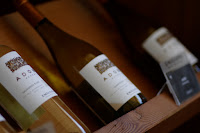
Text and photos by Jason McKenney
"One breed of plant can be used fend off another that's intruding. Certain flowers attract specific insects needed to destroy a fungus that can kill the vines. Bugs provide food for the birds. The birds help spread the seeds of the plants. Pesticides and herbicides are never used." The tour guide, a plucky young woman called Meredith, was explaining to us the details of what makes a winery not just organic, but biodynamic.
The basics are as follows: "Organically Grown" means the grapes are grown without the use of pesticides, herbicides or chemicals. That's pretty standard and most people are familiar with the term.
 |
| Bottles of Adobe Reserva |
According to Meredith, "Being biodynamic is a holistic and biodiverse approach that regards the vineyard as a living thing that needs to be naturally nourished." This is about as close to nature untouched as one can get and still ferment something delicious.
 When hoping to become a body builder, anyone can lift weights and become stronger, but only those with the optimum set of genes will attain award-winning results. Similarly, any vineyard can attempt to be organic but only those with the best natural conditions will excel to generate world-class wines. Exhibit A is Emiliana Organico in the Casablanca and Calchagua Valleys in Chile.
When hoping to become a body builder, anyone can lift weights and become stronger, but only those with the optimum set of genes will attain award-winning results. Similarly, any vineyard can attempt to be organic but only those with the best natural conditions will excel to generate world-class wines. Exhibit A is Emiliana Organico in the Casablanca and Calchagua Valleys in Chile.The Casablanca location (where we were on this day) is situated between Santiago and the Pacific Coast while Calchagua lies roughly 80 miles south of Santiago. The Casablanca region boasts some of the best wineries in Chile. With warm, dry days, cool evenings, and moderate rainfall, the climate is uniquely well suited to organic farming and provides a wonderful canvas from which wine makers can create their art.
 |
| A biodynamic environment |
Emiliana was founded in 1986. Not every wine is yet certified biodynamic as owners continue to convert as many of their vineyards as possible to this rigorous approach. Their super-premium Emiliana Gê and Coyam are both made in accordance with biodynamic principals. Gê's debut
vintage was 2003. It marked the release of South America's first ever certified biodynamic wine. As of today, Emiliana constitutes the single largest source of estate-grown organic wines in the world.
 |
| Herb garden |
Coyam is a red blend (41% Syrah, 29% Carmenere, 20% Merlot, 7% Cabernet Sauvignon, 2% Mourvedre, 1% Petit Verdot) with soft tannins and tasting of red fruit interlaced with oak and toffee. Average price per bottle is around $27 US.
As opposed to the Emiliana vineyards in the Calchagua Valley, the vineyards in Casablanca specialized in growing grapes for white wines. Their Natura Chardonnay is well balanced, a bit citrusy, and certified organic.
A much better breakdown and analysis of Emiliana's wines than I could ever give can be found on the Wine Lover's Page.

 Each glass given to us was a full serving and was paired with a local cheese and some crackers. This was my first wine tasting outside the United States so I wasn't used to the apparent custom of not actually finishing a glass. After downing three glasses of wine I looked around the table and noticed that mine were the only glasses that were empty. My wife, a native of Chile, found this hilarious. "These are tediously constructed wines with immense amounts of effort put into the crafting of each bottle," I explained to her (or something along those lines). I felt it a sin against nature to waste even one drop.
Each glass given to us was a full serving and was paired with a local cheese and some crackers. This was my first wine tasting outside the United States so I wasn't used to the apparent custom of not actually finishing a glass. After downing three glasses of wine I looked around the table and noticed that mine were the only glasses that were empty. My wife, a native of Chile, found this hilarious. "These are tediously constructed wines with immense amounts of effort put into the crafting of each bottle," I explained to her (or something along those lines). I felt it a sin against nature to waste even one drop.The tour of the farm and vineyard helped me walk off some of my buzzed energy. Meredith showed us not only the vineyards, but the herb garden, the bee hives (don't get too close!), the fruit orchard, and some of the barnyard animals that call Emiliana home. A white alpaca walked up to a stone fence next to me and basically demanded I give it some leaves to eat.
Seeing Emiliana up close pulled together many of the staples of wine making that I love, namely, being self-sustaining, blending with the environment, and crafting something beautiful and pleasant by controlling the whims of nature. The winemakers at Emiliana are devout in their faith of being biodynamic and I look forward to testing (tasting) the results of their labor for years to come.


No comments:
Post a Comment